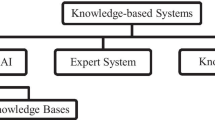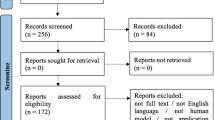Abstract
Mechanocomputational techniques in conjunction with artificial intelligence (AI) are revolutionizing the interpretations of the crucial information from the medical data and converting it into optimized and organized information for diagnostics. It is possible due to valuable perfection in artificial intelligence, computer aided diagnostics, virtual assistant, robotic surgery, augmented reality and genome editing (based on AI) technologies. Such techniques are serving as the products for diagnosing emerging microbial or non microbial diseases. This article represents a combinatory approach of using such approaches and providing therapeutic solutions towards utilizing these techniques in disease diagnostics.


Similar content being viewed by others
References
Liu C, Zhang L, Liu H, Cheng K (2017) Delivery strategies of the CRISPR-Cas9 gene- editing system for therapeutic applications. J Control Release 266:17–26. https://doi.org/10.1016/j.jconrel.2017.09.012
Liu J, Wen J, Zhang Z, Liu H, Sun Y (2015) Voyage inside the cell: microsystems and nanoengineering for intracellular measurement and manipulation. Microsyst Nanoeng 1:15020. https://doi.org/10.1038/micronano.2015.20
Siuly S, Zhang Y (2016) Medical big data: neurological diseases diagnosis through medical data analysis. Data Sci Eng 1:54–64. https://doi.org/10.1007/s41019-016-0011-3
Zarei M (2017) Advances in point-of-care technologies for molecular diagnostics. Biosens Bioelectron 98:494–506. https://doi.org/10.1016/j.bios.2017.07.024
Karsten SL, Tarhan MC, Kudo LC, Collard D, Fujita H (2015) Point-of-care (POC) devices by means of advanced MEMS. Talanta 145:55–59. https://doi.org/10.1016/j.talanta.2015.04.032
Dos Santos FLC, Paci M, Nanni L, Brahnam S, Hyttinen J (2015) Computer vision for virus image classification. Biosystems Eng 138:11–22. https://doi.org/10.1016/j.biosystemseng.2015.01.005
Qiu X, Ge S, Gao P, Li K, Yang S, Zhang S, Ye X, Xia N, Qian S (2017) A smartphone-based point-of-care diagnosis of H1N1 with microfluidic convection PCR. Microsyst Technol 23:2951–2956. https://doi.org/10.1007/s00542-016-2979-z
Chakradhar S (2017) Predictable response: finding optimal drugs and doses using artificial intelligence. Nat Med 23:1244–1247. https://doi.org/10.1038/nm1117-1244
Sareen S, Gupta SK, Sood SK (2017) An intelligent and secure system for predicting and preventing Zika virus outbreak using Fog computing. Enterp Inf Syst 11:1436–1456. https://doi.org/10.1080/17517575.2016.1277558
Cao Y, Liu C, Liu B, Brunette MJ, Zhang N, Sun T, Zhang P, Peinado J, Garavito ES, Garcia LL, Curioso WH (2017) Improving tuberculosis diagnostics using deep learning and mobile health technologies among resource-poor communities in Peru. Smart Health 1:66–76. https://doi.org/10.1109/chase.2016.18
Li B, Li B, Guo T, Sun Z, Li X, Li X, Chen L, Zhao J, Mao Y (2017) Artificial neural network models for early diagnosis of hepatocellular carcinoma using serum levels of α-fetoprotein, α-fetoprotein-L3, des-γ-carboxy prothrombin, and golgi protein. Oncotarget 8:80521–80530. https://doi.org/10.18632/oncotarget.19298
Cheng Y, Liu C, Zhang N, Wang S, Zhang Z (2014) Proteomics analysis for finding serum markers of ovarian cancer. BioMed Res 2014:1–9. https://doi.org/10.1155/2014/179040
Kumar V, Chhabra D, Shukla P (2017) Xylanase production from Thermomyces lanuginosus VAPS-24 using low cost agro-industrial residues via hybrid optimization tools and its potential use for saccharification. Bioresour Technol 243:1009–1019. https://doi.org/10.1016/j.biortech.2017.07.094
Baweja M, Singh PK, Shukla P (2016) Enzyme technology, functional proteomics and systems biology toward unraveling molecular basis for functionality and interactions in biotechnological processes. In: Shukla P (ed) Frontier discoveries and innovations in interdisciplinary microbiology. Springer, India, pp 207–212. https://doi.org/10.1007/978-81-322-2610-9_13
Vijayvargiya S, Shukla P (2013) Regulatory motif identification in biological sequences: an overview of computational methodologies. In: Shukla P, Pletschke B (eds) Advances in enzyme biotechnology. Springer, India, pp 111–124. https://doi.org/10.1007/978-81-322-1094-8_8
Kurzrock R, Stewart DJ (2016) Click chemistry, 3D-printing, and omics: the future of drug development. Oncotarget 7:2155. https://doi.org/10.18632/oncotarget.6787
Daneshmand M, Bilici O, Bolotnikova A, Anbarjafari G (2017) Medical robots with potential applications in participatory and opportunistic remote sensing: a review. Robot Auton Syst 95:160–180. https://doi.org/10.1016/j.robot.2017.06.009
Tonutti M, Gras G, Yang GZ (2017) A machine learning approach for real-time modelling of tissue deformation in image-guided neurosurgery. Artif Intell Med 80:39–47. https://doi.org/10.1016/j.artmed.2017.07.004
Kalia VC (2013) Quorum sensing inhibitors: an overview. Biotechnol Adv 31:224–245. https://doi.org/10.1016/j.biotechadv.2012.10.004
Kumar R, Koul S, Kumar P, Kalia VC (2016) Searching biomarkers in the sequenced genomes of Staphylococcus for their rapid identification. Indian J Microbiol 56:64–71. https://doi.org/10.1007/s12088-016-0565-9
Koul S, Kumar P, Kalia VC (2015) A unique genome wide approach to search novel markers for rapid identification of bacterial pathogens. J Mol Genet Med 9:194. https://doi.org/10.4172/1747-0862.1000194
Author information
Authors and Affiliations
Corresponding author
Rights and permissions
About this article
Cite this article
Vashistha, R., Chhabra, D. & Shukla, P. Integrated Artificial Intelligence Approaches for Disease Diagnostics. Indian J Microbiol 58, 252–255 (2018). https://doi.org/10.1007/s12088-018-0708-2
Received:
Accepted:
Published:
Issue Date:
DOI: https://doi.org/10.1007/s12088-018-0708-2




